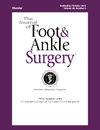Comparative clinical outcomes of K-wire fixation versus screw fixation in Lisfranc joint injuries: A multicenter (TRON group) retrospective study
IF 1.3
4区 医学
Q2 Medicine
引用次数: 0
Abstract
Treatment of Lisfranc joint injuries commonly involves surgical fixation, with screw fixation and Kirschner wire (K-wire) fixation being two primary methods. However, the optimal fixation strategy remains debated, particularly regarding functional outcomes and complications. This multicenter retrospective study analyzed 50 patients (25 per group) who underwent either screw or K-wire fixation for Lisfranc injuries between 2014 and 2024. Patients were matched by age and sex. Outcomes were assessed using AOFAS midfoot scores, complication rates, and radiographic evaluation. Operative time was significantly shorter in the K-wire group (41.0 vs. 118.5 min, p < 0.001). AOFAS scores showed no significant difference between groups (median of 88.0 vs. 90.0, p = 0.84). The K-wire group showed higher rates of malunion (28.0 % vs. 4.0 %, p = 0.049), whereas the screw group had increased rates of implant breakage (12.0 %, p = 0.012), wound irritation (36.0 %, p = 0.095), and unplanned implant removal (28.0 %, p < 0.001). Both fixation methods achieved comparable functional outcomes, which were assessed in patients who were followed for at least 90 days. K-wire fixation offered advantages in shorter operative time and fewer hardware-related complications but showed higher rates of malunion. Treatment choice should be individualized based on patient factors and injury characteristics, with K-wire fixation representing a viable alternative in appropriate cases.
一项多中心(TRON组)回顾性研究:k线固定与螺钉固定治疗Lisfranc关节损伤的临床效果比较。
治疗Lisfranc关节损伤通常包括手术固定,螺钉固定和克氏针(k -丝)固定是两种主要方法。然而,最佳固定策略仍有争议,特别是关于功能结果和并发症。这项多中心回顾性研究分析了2014年至2024年间接受螺钉或k线固定治疗Lisfranc损伤的50例患者(每组25例)。患者按年龄和性别进行配对。结果通过AOFAS中足评分、并发症发生率和影像学评价进行评估。k线组手术时间明显缩短(41.0 min vs. 118.5 min, p < 0.001)。各组间AOFAS评分差异无统计学意义(中位数为88.0比90.0,p = 0.84)。k线组的畸形愈合率较高(28.0% vs. 4.0%, p = 0.049),而螺钉组的假体断裂率较高(12.0%,p = 0.012),伤口刺激率较高(36.0%,p = 0.095),计划外假体拔出率较高(28.0%,p < 0.001)。在随访至少90天的患者中,对两种固定方法的功能结果进行了评估。k线内固定具有手术时间短、并发症少的优点,但其畸形愈合率较高。治疗选择应根据患者因素和损伤特征进行个体化,在适当情况下,钢丝固定是一种可行的选择。
本文章由计算机程序翻译,如有差异,请以英文原文为准。
求助全文
约1分钟内获得全文
求助全文
来源期刊

Journal of Foot & Ankle Surgery
ORTHOPEDICS-SURGERY
CiteScore
2.30
自引率
7.70%
发文量
234
审稿时长
29.8 weeks
期刊介绍:
The Journal of Foot & Ankle Surgery is the leading source for original, clinically-focused articles on the surgical and medical management of the foot and ankle. Each bi-monthly, peer-reviewed issue addresses relevant topics to the profession, such as: adult reconstruction of the forefoot; adult reconstruction of the hindfoot and ankle; diabetes; medicine/rheumatology; pediatrics; research; sports medicine; trauma; and tumors.
 求助内容:
求助内容: 应助结果提醒方式:
应助结果提醒方式:


